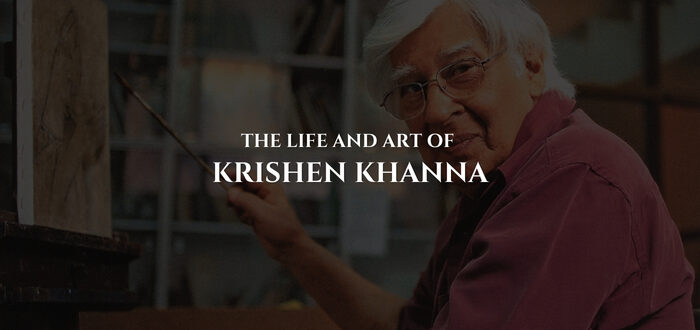The Life and Art of Krishen Khanna
Today we are taking a look at the life and artworks of an artist who influenced the contemporary Artscape, the only surviving member of the Progressive Artists’ Group, and a pivotal member of the group – Krishen Khanna. With a career spanning almost eight decades, his works are a reflection of his personal experiences. He comes from a generation that experienced the turmoil of partition, the euphoria of independence, and also navigated through the transformation after the post-independence. His works are mostly inspired by biblical tales, the pathos of partition and the wedding band musicians also known as the Bandwallahs.
From Lahore to Shimla: The Formative Years of Krishen Khanna
Krishen Khanna was born in 1925 in Faisalabad, Punjab, and grew up in Lahore. His passion for art was ignited when his father bought Leonardo Da Vinci’s Self Portrait and The Last Supper. At the age of 13 in 1938, he moved to England to study art for the first time on a scholarship at the Imperial Service College in Windsor. After graduating in 1942, he moved back to Lahore where he enrolled in the Government College and pursued B. A. honours in English literature. Then came the most important year of his life, in 1946 he started working as an apprentice at Studio One under the painter Sheikh Ahmed and also worked at Kapoor Art Works. He acquired the skill of painting as well as printing while working at both places. With his first income, he bought a painting by Prannath Mago which marked the start of his artistic journey.
Due to the communal riots in the coming years, it became difficult for the Khanna family to live in Lahore. So, in 1947 the family moved to Shimla.
The Choice between ledger and canvas
In 1948, a settled life began for him as he got a job in Mumbai as an officer in Grindlay’s Bank. So his art career took almost a different path. His love for art was overshadowed by the demanding bank job. For many years, he continued to juggle between the two. He found solace in his artwork, the wounds inflicted because of the partition still stank and the only way for him to express his grief was to paint it on the canvas.
During his time in Mumbai, he met S.B. Palsikar who introduced him to Progressive Artists’ Group. With their support and encouragement, he exhibited his first work. Later on, his painting News of Gandhi’s Death was selected to be exhibited at the Bombay Art Society.
After fourteen of juggling between the two, he made an important decision to dedicate his entire life to art. On his final day at the bank, his fellow artist friends M.F Husain, Bal Chhabda, and V S Gaitonde were waiting outside the gate all set to celebrate his freedom.
Style
In the early years of his career, he focused more on figurative art depicting the people and scenes of Southern India. Later on, influenced by expressionists like Rothko his style shifted to poetic abstraction. Eventually, he again came back to his figurative art style portraying social realities drawn from photographs. Along with oil paints, Khanna also experimented with acrylics, ink, and pencil. In Washington, D.C. and New York City (1964–65), he moved toward pure abstraction and experimented with some new techniques such as Japanese ink painting, which he learned during his Rockefeller Fellowship in Japan and used in one of his works.
Theme
His early works depicted the lives of the fisher folks in Southern India, capturing their sunlit complexions and the dynamic moods of the sea. However, as his at matured, so did his themes as he shifted towards introspective and somber compositions. His landscapes had become abstract pieces by the early 1960s with Japanese inspiration in the Sumi-e technique. As he witnessed the aftermath of the 1965 Indo-Pak war, a darker and more serious tone poured into his works.
Khanna’s move to social and ironic themes began in the late 1960s when he started describing scenes from everyday life from the middle class. Images of fruit and vegetable vendors on city streets, street performers surrounded by curious children, people lounging in local cafés and dhabas, and the bandwallahs dressed in bright red uniforms abound in his paintings. He also painted the vibrancy of festivals and other public processions.
The Bandwallahs
Moving on from discussing Krishen Khanna’s birth, themes, and style of work, it would be apt to bring up one of his most iconic subjects—the bandwallahs
Bandwallahs became a significant theme in Khanna’s works at the beginning of the 1980s depicting his ability to capture the emotions and experiences of the lives of ordinary people. The bandwallahs in their bright red uniforms, adorned with gold epaulets and brass buttons, contrasted with their expressions of being worn out by playing the repetitive tunes at countless wedding processions.
Moving from muted colors in most of his works, Khanna used the intense reds of the bandwallah series to depict their lives as the most marginalized musicians. Hired for celebrations and wedding processions, these bandwallahs are often excluded from experiencing the joy which they help to create. Khanna deeply sympathized with them. This emotion is quite evident in his paintings and sculptures where these musicians bring gaiety to the events of the middle class while their well-being remains neglected.
During the pandemic, he focused on the destiny of these musicians, considering their position in a world when festivities and gatherings were limited. He found a fresh energy in his work by exploring bandwallah imagery without the limits of traditional drawing or composition, allowing him to express his full spectrum of artistic capabilities.
Khanna’s relationship to the bandwallahs extends beyond admiration for their craft; he sees them as symbols of the “post-Partition” experience, sharing a sense of relocation and uncertainty. The bandwallahs, like many who have relocated across borders, are navigating a new world, waiting for opportunities to demonstrate their skills during weddings, which may sometimes feel like the only times they are truly appreciated.
Turn your walls into masterpieces
Works at the Giftex Auction
We are pleased to feature a magnificent bandwallah sculpture in our upcoming Giftex auction on Modern and Contemporary Art to be held on October 14th and 15th. Bandwallah, a remarkable piece by renowned Indian artist Krishen Khanna, was produced in 1925. This bronze sculpture is part of a limited edition of nine, particularly numbered Ed: 3/9. This painting, which was shown in the 2019 group exhibition ‘Bronzed: From Paint to Patina’ at the Institute of Contemporary Indian Arts in Mumbai, drew notice for its detailed intricacies and profound symbolism. It is featured in the accompanying publication, which highlights Khanna’s contribution to contemporary Indian art (p. 64). This work beautifully displays Krishen Khanna’s commitment to depicting the lives of marginalised populations and celebrating their rich cultural histories. We invite you to attend the auction and explore this unique work of art, as well as other exceptional works celebrating India’s artistic history.







